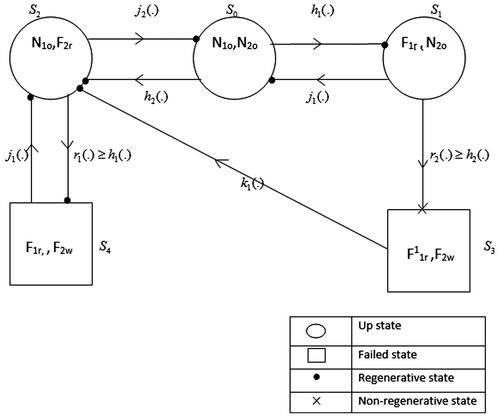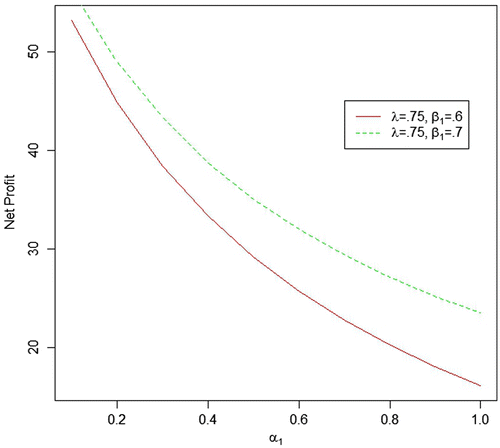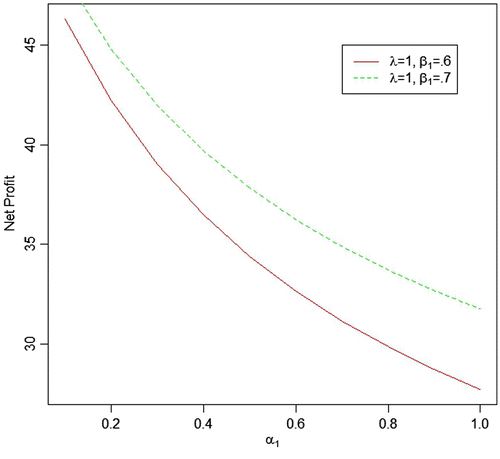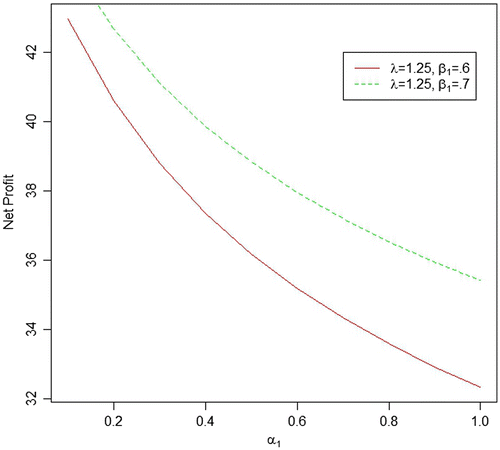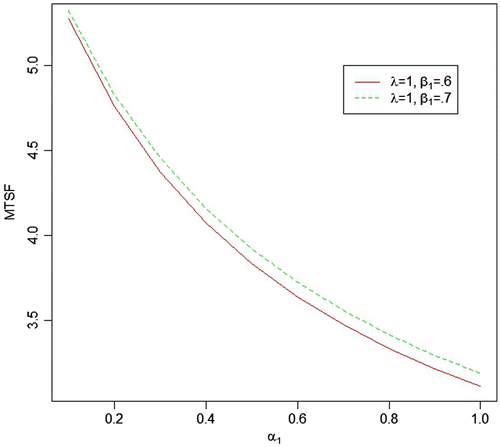 ?Mathematical formulae have been encoded as MathML and are displayed in this HTML version using MathJax in order to improve their display. Uncheck the box to turn MathJax off. This feature requires Javascript. Click on a formula to zoom.
?Mathematical formulae have been encoded as MathML and are displayed in this HTML version using MathJax in order to improve their display. Uncheck the box to turn MathJax off. This feature requires Javascript. Click on a formula to zoom.Abstract
The crux of the study is to investigate a two non-identical unit parallel system where priority is given to first unit. The system consists of two non-identical units arranged in parallel configuration. System failure occurs when both the units stop Working. Weibull failure and repair time distributions of each unit are taken. Several measures of system effectiveness, such as reliability, MTSF, steady state availability, expected profit etc., useful to system managers are obtained by using regenerative point technique. Further, recognizing the fact that the life testing experiments are very time consuming, the parameters representing the reliability characteristics of the system/unit are assumed to be random variables. Both informative and non-informative prior are used for the Bayesian analysis. Therefore, a simulation study is also conducted for analysing the considered system model both in classical and Bayesian setups.
Public Interest Statement
The determination of the reliability measures of a complex system, composed of a number of interconnected subsystems, has received much attention over the years. The most of the above studies were mainly concerned to obtain various reliability characteristics such as meantime to system failure (MTSF), point wise and steady state availabilities etc., by using exponential distribution as failure and repair time distribution of units but not to estimate the parameter(s) involved in the life time/repair time distribution of system/unit. Similarly, in real world, assuming constant failure and repair time distribution of units is not realistic. Therefore, the present study aims to investigate a two non-identical unit parallel system where priority is given to first unit with non-Markovian behaviors of hazard and repair along with estimation problem of unknown parameters.
1. Introduction
Any equipment or system manufactured is designed with assured objectives to meet up its goals in terms of production/service. A reliable equipment is the one which works satisfactorily for a given time period under given environmental conditions without any interruptions. A high degree of reliability is an absolute necessity. No one can afford to take risk with a device which does not operate particularly at an instant when human life and national security is at stake.
Besides this, the complexity of technological system and their products are increasing day by day and hence thrown a challenge before designers, engineers, manufactures for the reliable performance of their system. Therefore, the objectives of reliability are many fold and include the following (Mishra, Citation2006):
| • | adequate performance of system/equipment for a specified duration | ||||
| • | hang on to precise environmental conditions | ||||
| • | control on downtime of system/equipment | ||||
| • | crisis free running of system/equipment | ||||
Reliability measures are very effective and efficient tool for probabilistic risk assessment in system design, operation and maintenance. The determination of the reliability measures of a complex system composed of a number of interconnected subsystems has received much attention over the years. Gupta and Sharma (Citation1993), Rehmert and Nachlas (Citation2009), Ghasemi, Yacout, and Ouali (Citation2010) have reported substantial work in the field of reliability analysis, by considering complex systems with different failure and repair policy.
Reliability analysis of parallel systems has been broadly studied by Gupta and Agarwal(Citation1984), Dhillon and Anuda (Citation1993a, Citation1993b), Sridharan and Mohanavadivu (Citation1997), Kumar, Bharti, and Gupta (Citation2012) and the reference cited therein. Dhillon and Anuda (Citation1993a) studied the common cause failure analysis of a two non-identical unit parallel system with arbitrarily distributed repair times. Chopra and Ram (Citation2017) study stochastic analysis of two non-identical unit parallel system incorporating waiting time. El-Sherbeny (Citation2017) investigates the influence of the system parameters on a system consisting of a 2-unit cold standby system with a single repair person. Considering the issue of high cost of similar units and giving priority to one of the units in repair as compared to other, Malik, Bhardwaj, and Grewal (Citation2010) develop a reliability model for a system of non-identical units-one is original and the other unit as duplicate (called sub-standard unit). However, there may be a situation, where priority to a specified unit in repair may be given to avoid unnecessary inspections e.g. In the hilly region, there are two roads named A and B, respectively. Both are non-identical units i.e. road A is a highway whereas road B is a link road. Both roads connect to the same destination from same starting place and work parallel. In tight corner, such as snowfall, landslide etc. while both roads A and B get damaged, priority of repairing is given to road A in lieu of road B. Second instance, there are two non-identical turbines “X” and “Y” are working parallel. Turbine X has more capacity than turbine Y. In those circumstances, when both turbines stopped working, turbine X gets priority in repairing.
The most of the of the above studies were mainly concerned to obtain various reliability characteristics such as meantime to system failure (MTSF), point wise and steady state availabilities etc., by using exponential distribution as failure and repair time distribution of units and not to estimate the parameter(s) involved in the life time/repair time distribution of system/unit. However, in real world, assuming constant failure and repair time distribution of units is not realistic. The Weibull distribution has been widely used in reliability and survival analysis, especially for describing the fatigue failures. Weibull (Citation1951) used this distribution for vacuum tube failures while Lieblein and Zelen (Citation1956) consider it for ball bearing failures. Singh, Rathi, and Kumar (Citation2013) attempt classical and Bayesian analysis of a k-components load-sharing parallel system model assuming the failure time distribution of the components as Weibull. Chaturvedi, Pati, and Tomer (Citation2014) consider robust Bayesian analysis of the Weibull failure model under a sigma-contamination class of priors for the parameters. Recently, Gupta and Singh (Citation2017) performed classical and Bayesian analysis of Weibull parameters in presence of outlier. Also, Dey, Alzaatreh, Zhang, and Kumar (Citation2017) introduce a new generalization of Weibull distribution called alpha-power transformed Weibull distribution that provides better fits than the Weibull distribution and some of its known generalizations. We refer to Mann (Citation1968) and the reference cited therein, where Weibull distribution gives a variety of situations in which this distribution can be used for various types of data.
In view of the above concerns, the purpose of the present study is to two fold. First, we analyse a two non-identical unit parallel system model by incorporating Weibull distribution for both failure and repair times with same shape parameter but different scale parameters. It is well known that the Weibull distribution has been frequently used in life-testing and survival analysis especially for describing the fatigue failures. Weibull (Citation1951) utilized this model for vacuum tube failures and Lieblein and Zelen (Citation1956) also assumed the same for ball bearing failures. Singh et al. (Citation2013) analysed the k-components load-sharing parallel system model by considering the failure time distribution of the load-sharing components as Weibull. Recently, Gupta and Singh (Citation2017) considered the parameter estimation of Weibull model in presence of outlier. We refer to Mann (Citation1968) and the reference cited therein, where Weibull distribution gives a variety of situations in which this distribution can be used for various types of data.
Secondly, on the other hand, assuming the parameters involved in the model as random variable, a simulation study is attempted for analysing the considered model in classical as well as Bayesian set-up. ML estimates of the parameters, MTSF and Profit function with their standard errors (SEs) and corresponding length of the confidence interval are observed. For obtaining Bayes estimates, we assumed both informative and non-informative prior for the model parameters. At the end, comparison is made through simulation study to judge the performance of ML and Bayes estimates for various values of the failure and repair parameters.
2. System model description, notations and states of the system
The system made by two non-identical units (unit-1 and unit-2) arranged in parallel network. Each unit has two Modes-Normal (N) and total failure (F). The first unit has priority in repair. Units will be work as good as new after repair. System will fail when both units stop working. The failure rate of operative unit has increased when system operates with only one unit in comparison to the situation when both the units are operative. The failure and repair time distribution of each unit are taken to be independent having the Weibull density with common shape parameter λ and different scale parameters α and β as follows:
and
where t ≥ 0; αi and βi, λ > 0 and i = 1, 2, respectively, for unit-1 and unit-2.
2.1. Notations
Table
2.2. Symbols for the states of the system
Table
Using the above symbols, the possible states of the system are represented in the transition diagram shown in Figure where S0, S1 and S2 are the up states and S3 and S4 are failed states. It is also verified that the state S3is non-regenerative state.
3. Transition probabilities, sojourn times and conditional mean sojourn times
3.1. Transition probabilities
Transition probability matrix (TPM) of the implanted Markov Chain is given by:
With non-zero elements:(1)
(1)
and the other elements of TMP will be zero.
Without loss of generality, the following expressions can be easily obtained p01 + p02 = 1, , p20 + p24 = 1.
3.2. Sojourn times
The corresponding value of the mean sojourn time ψi; i = 0, 1, 2, 4 for various regenerative states are as follows:(2)
(2)
Conditional mean sojourn time:
Values of the conditional mean sojourn time for various regenerative states are as follows:(3)
(3)
4. Measures of system effectiveness
4.1. Reliability and MTSF of the system
To determine Ri(t), we consider the failed state S3 and S4 of the system as absorbing state. By the probabilistic arguments, we have:(4)
(4)
(5)
(5)
(6)
(6)
where ,
and
.
Taking Laplace transformations of Equations (4), (5) and (6) and simplifying for , we get:
(7)
(7)
After obtaining the inverse Laplace transformations of equation (7), one can easily get the reliability of the system when it initially starts from stateS0.
When system primarily starts from state S0, the MTSF is given by:(8)
(8)
4.2. Availability analysis
By simple probabilistic arguments, we have the following recursive relation in Ai(t):(9)
(9)
(10)
(10)
(11)
(11)
(12)
(12)
After taking the Laplace transform of equations (9), (10), (11) and (12) and simplifying for , we get
(13)
(13)
Taking inverse Laplace transform of equation (13), we can get availability of the system for known value of parameters.
In the long run, the steady state probability that the system will be operate, is given by:(14)
(14)
The expected up time of the system during time interval (0, t) is given by:
So that:(15)
(15)
4.3. Busy period analysis
By simple probabilistic arguments, we have the following recursive relation in Bi(t): (i = 0, 1, 2, 4):(16)
(16)
(17)
(17)
(18)
(18)
(19)
(19)
where, .
Taking the Laplace transformation of relations (16, 17, 18 and 19) and simplifying for , omitting the argument’s’ for brevity, we get:
(20)
(20)
In the long run, the steady state probability that the repairman will be busy in the repair of a failed unit, is, given by:(21)
(21)
The expected busy period of the repairman during time interval (0, t) is:
So that(22)
(22)
4.4. Profit analysis
The net expected profit incurred by the system during the time interval (0, t) is given by:(23)
(23)
where K0 is the revenue per unit up time by the system and K1is the amount paid to the repairman per unit time when the system is under repair. The net expected profit incurred by the system per unit of time in steady state is given by:(24)
(24)
where A0 and B0 has been defined already in previous sections.
5. Estimation of parameters, MTSF and profit function
5.1. Classical estimation
Let us assume that the failure, increased failure and repair times are independently Weibull-distributed random variables with failure rates h1(.),h2(.) increased failure ratesr1(.), r2(.) and the repair ratesj1(.), j2(.), respectively, where:
,
and
t > 0,
Here αi, βi μi and are scale parameters while λ is the shape parameter.
In our study, we are interested with the ML estimation procedure as one of the most important classical procedures.
Let six independent samples of size drown from Weibull distribution with failure rates h1(.), h2(.), r1(.), r2(.) and repair rates j1(.), j2(.), respectively
The likelihood function of the combined sample is:(25)
(25)
By using maximization likelihood approach, the ML estimates (say ) of the parameters α1, α2, μ1, μ2, β1, β2
Without loss of generality, using the invariance property of MLE, the MLEs of MTSF and profit function, say and
can be easily obtained. The asymptotic distribution of
where I denotes the Fisher information matrix with diagonal elements
Also non diagonal elements are all zero.
Also, the asymptotic distribution of and
where
and
5.2. Bayesian estimation
Assuming the parameters involved in the model as random variable, we have also considered the Bayesian methods of estimation. The prior distributions of scale parameters α1, α2, μ1, μ2, β1, β2(when the shape parameter λ is known) are assumed to be gamma distribution with parameters (θi, δi; i = 1, 2, …, 6) and are given as follows:(26)
(26)
Here, the parameters of prior distributions are called hyper parameters. Using the likelihood function in equation (25) and prior distribution of α1, α2, μ1, μ2, β1, β2 considered in the Equation (26), the posterior distributions are as follows:(27)
(27)
(28)
(28)
(29)
(29)
(30)
(30)
(31)
(31)
(32)
(32)
Under the squared error loss function, Bayes estimates of α1, α2, μ1, μ2, β1, β2 are, respectively, the means of posterior distribution given in Equations (27)–(32) and as follows:(33)
(33)
6. Simulation study
In this section, a simulation study is performed to validate the theoretical developments. The standard errors of the estimates and widths of the confidence/HPD intervals are used for comparison purpose. Since, the shape of the hazard rate of Weibull lifetime model is increasing, decreasing and constant as well for different values of the shape parameter; hence, we assume the following values of the model parameters to conduct the simulation study:
| • | n = 100, β1 = 0.6, β2 = 0.5, μ1 = 0.5, μ2 = 0.6 Z and λ = 0.75 | ||||
| • | n = 100, β1 = 0.7, β2 = 0.5, μ1 = 0.5, μ2 = 0.6 and λ = 0.75 | ||||
| • | n = 100, β1 = 0.6, β2 = 0.5, μ1 = 0.5, μ2 = 0.6 and λ = 1.00 | ||||
| • | n = 100, β1 = 0.7, β2 = 0.5, μ1 = 0.5, μ2 = 0.6 and λ = 1.00 | ||||
| • | n = 100, β1 = 0.6, β2 = 0.5, μ1 = 0.5, μ2 = 0.6 and λ = 1.25 | ||||
| • | n = 100, β1 = 0.7, β2 = 0.5, μ1 = 0.5, μ2 = 0.6 and λ = 1.25 | ||||
We generated six data sets with respect to the above-mentioned different values of parameters, respectively, and based on these data sets, the MLEs and Bayes estimates (for both informative and non-informative prior) for the parameters, system MTSF and net profit have been obtained. Bayes estimates of the parameters with gamma priors have been obtained by setting the values of prior’s parameters as α1 = E(α1) = δ1/θ1and similarly for rest of the model parameters and put the values of all prior’s parameters as zero to obtain Bayes estimates with Jeffrey’s priors. The various estimates of the MTSF and Profit along with their SEs/PSEs and length of the confidence/HPD intervals have been summarized in Table . The value of the constant K0 and K1 are taken as 150 and 50, respectively. For more real study of the system, we have also plot curves of the MTSF and net profit for different values of α1, β1 and λ while keeping the other parameters fix. For all the numerical computations, the programs are developed in R-environment and are available with the authors.
Table 1. Various estimates of MTSF for fixed λ = 0.75, β1 = 0.6 and varying α1
Table 2. Various estimates of profit for fixed λ = 0.75, β1 = 0.6 and varying α1
Table 3. Various estimates of MTSF for fixed λ = 1.00, β1 = 0.6 and varying α1
Table 4. Various estimates of profit for fixed λ = 1.00, β1 = 0.6 and varying α1
Table 5. Various estimates of MTSF for fixed λ = 1.25, β1 = 0.6 and varying α1
Table 6. Various estimates of profit for fixed λ = 1.25, β1 = 0.6 and varying α1
Table 7. Various estimates of MTSF for fixed λ = 0.75, β1 = 0.7 and varying α1
Table 8. Various estimates of profit for fixed λ = 0.75, β1 = 0.7 and varying α1
Table 9. Various estimates of MTSF for fixed λ = 1.00, β1 = 0.7 and varying α1
Table 10. Various estimates of profit for fixed λ = 1.00, β1 = 0.7 and varying α1
Table 11. Various estimates of MTSF for fixed λ = 1.25, β1 = 0.7 and varying α1
Table 12. Various estimates of profit for fixed λ = 1.25, β1 = 0.7 and varying α1
7. Concluding remarks
From the simulation results in Table and various plots in Figures , it is observed that:
| • | For the fixed value of β1 and λ, MTSF and net profit decreases as the failure rate of first unit α1increases. | ||||
| • | As the repair rate of first unit β1increases from 0.5 to 0.6, both MTSF and net profit increases. | ||||
| • | As the value of shape parameter λ (0.75, 1.00, 1.25) increases, the value of MTSF decreases with respect to all values of α1 which may be due to increase in the failure rate as the value of shape parameter increases. | ||||
| • | For the small values of | ||||
| • | Bayes estimation with gamma prior provides more precise estimates (in respect of SE/PSE and width of the HPD/confidence interval) as compared to the others. Also Jeffrey priors perform better than the MLEs even they are quite similar when α1 → 1.0. | ||||
Funding
The authors received no direct funding for this research.
Additional information
Notes on contributors
Pramendra Singh Pundir
Pramendra Singh Pundir received his PhD degree in Statistics from the CCS University, Meerut, India. Currently, Serving as Assistant Professor in the Department of Statistics, University of Allahabad, Allahabad, India. His research interests include Applied Statistics, Bayesian inference, load-sharing models, distribution theory and reliability analysis.
Rohit Patawa
Rohit Patawa received his MSc degree in Statistics from University of Allahabad, Allahabad India. He is, currently, a DPhil Student at Department of Statistics, University of Allahabad, Allahabad, India. His research interests include Applied Statistics, Bayesian inference, Time Series analysis, distribution theory, reliability analysis and data mining.
Puneet Kumar Gupta
Puneet Kumar Gupta received his MPhil degree in Statistics from the CCS University, Meerut, India. He is, currently, a research scholar at Department of Statistics, University of Allahabad, Allahabad, India. His research interests include Applied Statistics, Bayesian inference, load-sharing models, distribution theory and reliability analysis.
References
- Chaturvedi, A., Pati, M., & Tomer, S. K. (2014). Robust Bayesian analysis of Weibull failure model. Metron, 72(1), 77–95.
- Chopra, G., & Ram, M. (2017). Stochastic analysis of two non-identical unit parallel system incorporating waiting time. International Journal of Quality & Reliability Management, 34(6). doi:10.1108/IJQRM-06-2016-007
- Dey, S., Alzaatreh, A., Zhang, C., & Kumar, D. (2017). A new extension of generalized exponential distribution with application to Ozone data. Ozone: Science & Engineering, 39(4), 273–285.
- Dhillon, B. S., & Anuda, O. C. (1993a). Common cause failure analysis of a non- identical unit parallel system with arbitrarily distributed repair times. Microelectronics Reliability, 33(1), 87–103.10.1016/0026-2714(93)90048-4
- Dhillon, B. S., & Anuda, O. C. (1993b). Common cause failure analysis of a parallel system with warm standby. Microelectronics Reliability, 33(9), 1321–1342.10.1016/0026-2714(93)90133-J
- El-Sherbeny, M. S. (2017). Stochastic behavior of a two-unit cold standby redundant system under poisson shocks. Arabian Journal of Science and Engineering., 42, 3043–3053.10.1007/s13369-017-2515-1
- Ghasemi, A., Yacout, S., & Ouali, M. S. (2010). Evaluating the reliability function and the mean residual life for equipment with unobservable states. IEEE Transactions on Reliability, 59(1), 45–54.10.1109/TR.2009.2034947
- Gupta, P. P., & Agarwal, S. C. (1984). A parallel redundant complex system with two types of failure under preemptive-repeat repair discipline. Microelectronics Reliability, 24(3), 395–399.10.1016/0026-2714(84)90462-1
- Gupta, P. P., & Sharma, M. K. (1993). Reliability and MTTF evaluation of a two duplex unitstandby system with two types of repair. Microelectronics Reliability, 33(3), 291–295.10.1016/0026-2714(93)90014-P
- Gupta, P. K., & Singh, A. K. (2017). Classical and Bayesian estimation of Weibull distribution in presence of outliers. Cogent Mathematics, 4, 1300975.
- Kumar, P., Bharti, A., & Gupta, A. (2012). Reliability analysis of a two non-identical unit system with repair and replacement having correlated failures and repairs. Journal of informatics & Mathematical Sciences, 4(3), 339–350.
- Lieblein, J., & Zelen, M. (1956). Statistical investigation of the fatigue life of deep groove ball bearings. Journal of Research of the National Bureau of Standards, 57, 273–315.10.6028/jres.057.033
- Malik, S. C., Bhardwaj, R. K., & Grewal, A. S. (2010). Probabilistic analysis of a system of two non-identical parallel units with priority to repair subject to inspection. Journal of Reliability and Statistical Studies, 3(1), 1–11.
- Mann, N. (1968). Results on statistical estimation and hypotheses testing with application to the Weibull and extreme value distribution. Dayton, OH: Aerospace Research Laboratories Wright-Patterson Air Force Base.
- Mishra, R. C. (2006). Reliability and maintenance engineering. New Delhi: New Age International.
- Rehmert, I., & Nachlas, J. (2009). Availability analysis for the quasi-renewal process Systems. IEEE Transactions on Man and Cybernetics Part A Systems and Humans, 39(1), 272–280.10.1109/TSMCA.2008.2007945
- Singh, B., Rathi, S., & Kumar, S. (2013). Inferential statistics on the dynamic system model with time-dependent failure rate. Journal of Statistical Computation and Simulation., 83(1), 1–24.10.1080/00949655.2011.599327
- Sridharan, V., & Mohanavadivu, P. (1997). Reliability and availability analysis for two non-identical unit parallel system with conman cause failures and human errors. Microelectronics Reliability, 37(5), 747–752.10.1016/S0026-2714(96)00090-X
- Weibull, W. (1951). A statistical distribution function of wide applicability. Journal of Applied Mechanics, 18, 293–297.

